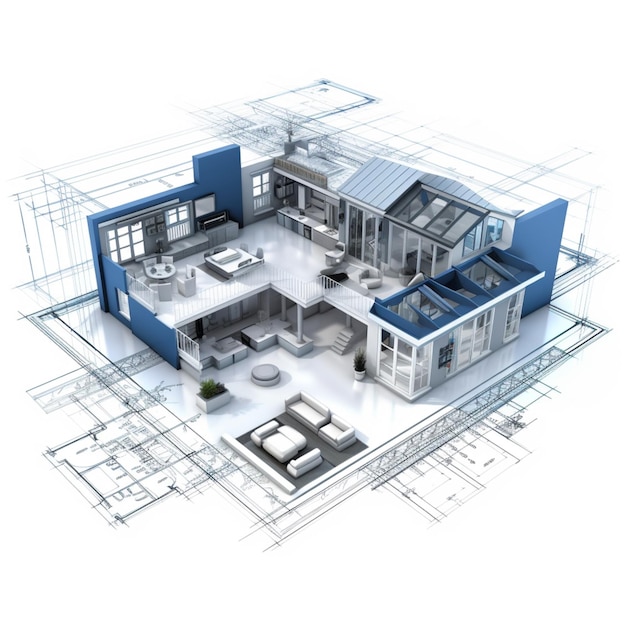
Artificial Intelligence (AI) in Architecture and Interior Design
Artificial Intelligence (AI) is here to reshape spaces in the world of architecture and interior design. AI-generated design assists architects and designers to unleash countless possibilities by creating realistic renderings for any project. From the world-famous Zaha Hadid to top architecture firms in India, architects are leveraging the power of AI algorithms to enhance their design processes. While architects are employing AI to generate complex and innovative architectural forms, interior designers are offering virtual simulations that personalize designs based on user preferences. The extent of AI implementation varies from project to project depending on its complexity, need, and goals. So today, let us understand how this fast-paced AI technology can assist in making your designs more efficient, innovative, and sustainable.
What is Artificial Intelligence (AI)?
Artificial Intelligence (AI) is a multidisciplinary approach that incorporates aspects of computer science, psychology, and sophisticated mathematics to create systems capable of learning, reasoning, problem-solving, perception, and language comprehension. In simple words, AI technology is the science of making machines that can think faster than humans, recognize patterns, process large amounts of data, and assist in making decisions,
It helps automate repetitive tasks and suggests design solutions for professionals. It assists in creative designing, optimizing planning and implementing the project.
Why should architects and interior designers use AI?
By integrating ground-breaking AI technology into their day-to-day work, architects and interior designers can innovate complex processes, reduce the amount of time spent on mundane tasks, improve the level of precision, introduce sustainability and have an edge over competition by making designs more unique, innovative, and efficient. Over 60% of all interior designers and architects are using some form of virtual or augmented reality. Today, not introducing AI in architecture and interior design means becoming a dinosaur in the field that thrives on foresight and evolution.
Contribution of AI in architecture and interior design
Statistics don’t lie. With the UN predicting the world population to reach 11.2 billion by 2100, there will be a great need for construction and infrastructure. As per stats, using AI in architecture and interior has shown positive results. It can –
– Increase efficiency by 30% in the design process, saving architects and interior designers precious time and resources,
– Lead to 10-15% potential savings in total construction costs,
– Reduce 50% planning errors leading to lower costs and schedule overruns,
– Save energy costs upto 35% by helping to create more sustainable designs,
– Reduce construction waste by 40%, and
– Improve project delivery by 60% with better profitability and higher client satisfaction.
While AI in the construction market is projected to reach USD 4,510 million by 2026, the global virtual reality in the interior design market is expected to hit around USD 1332.91 during the same period with a CAGR of 30-35% during the forecast period.
How top architects are using AI in Architecture
Several top architects in India have introduced AI to assist in the architectural design of mega-projects, from building airports to high-rises. AI algorithms are helping architects in:
i. Enhancing design efficiency
ii. Improving the visualization process of architectural designs
iii. Optimizing building performance in terms of energy efficiency to provide sustainable buildings
iv. Generating multiple design alternatives with predefined specifications by integrating Generative Adversarial Networks (GANs)
v. Improving structural analysis and simulation with AI
vi. Discovering and researching innovative materials to create structurally unique designs
vii. Provides simulation to improve structural analysis
viii. Minimizing delays and streamlining the construction process by using predictive algorithms
ix. Identifying potential risks with a more accurate risk assessment to resolve them in the initial construction process.
x. Facilitating overall project management equipped with better predictive abilities to take the best decisions

How top interior designers are using AI in Interior Design
AI can optimize the time and effort spent to design a space. Top interior designers in Mumbai have introduced AI algorithms to help in –
i. Analyzing interior design trends and market preferences
ii. Making interior design more interactive and accessible
iii. Creating more personalized designs in presentations using virtual reality
iv. Preparing more immersive design experiences
v. Generating precision 3D models and renders
vi. Optimizing layouts in space planning, colour recommendations
vii. Analysing materials and products that reduce carbon footprint for more sustainable interiors
viii. Facilitating any real-time design changes
ix. Data-driven calculations based on building codes, materials, budgets, etc.
x. Automating tedious and repetitive tasks
Conclusion
Integrating AI into the workflow is a game changer for architects and interior designers. AI is not just a tool for administrative or computational tasks but helps to unlock creativity itself.
AI is helping visualize architectural and interior designs by creating animated, hyper-realistic 3D models/renderings with unprecedented realism. Today, real time rendering, virtual reality, and augmented reality are becoming an integral part of these professions. AI is not just for holistic building performance in the present conditions, but it also offers predictive maintenance by escalating and enabling proactive preventive care. Integrating Artificial Intelligence (AI) in interior design and architecture is the only way to producing extraordinary buildings and interiors.
Though AI is still not a decision-making tool, it has become an optimization tool in the new era of creativity. AI algorithms have been used to design some famous landmarks like the Beijing Daxing International Airport, the Bloomberg European Headquarters in London, the Amager Bakke Waste-to-Energy Plant in Copenhagen, Blue and White Porcelain Buildings, Amsterdam. Today, architecture and interior AI tools like ArchiAI, BricsCAD, Midjourney, Adobe Firefly, Autodesk Spacemaker, Maket, ARK, ArkoAI, Decorilla, Image creator, SketchUp, Kaedim, Diffusion Bee, OpenArt are available to architects and designers to facilitate their work.
Artificial Intelligence (AI) in architecture and interior design is here to build a better future!





